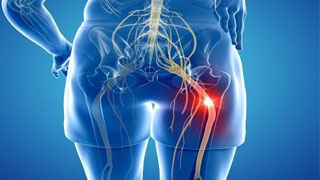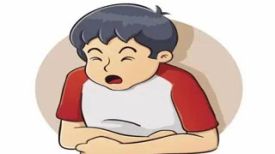
Sciatica is a symptom caused by compression of the sciatic nerve, which ranges from sensation and movement in the lower back to the feet. The sciatic nerve is the longest nerve in the human body, running from the lumbar spine through the lower back, buttocks, and back of the thigh, branching off behind the knee and extending to the lower legs and soles of the feet.
There are various causes of sciatica:
1. Intervertebral disc herniation: Commonly seen in people aged 40 to 60, the degeneration of physical function causes the intervertebral disc of the spine to protrude due to long-term compression, squeezing the sciatic nerve. People who frequently carry heavy objects, engage in lumbar exercises, sit for long periods of time, and have poor posture are also prone to the disease.
2. Bone spurs: Due to age, injury, and other wear and tear, the cartilage between bones may excessively proliferate and form bone spurs during body repair. If located in the spine, lumbar spine, femur, knee, and other areas, it can easily compress the sciatic nerve.
3. Lumbar spinal stenosis: It often occurs in people over 60 years old. The aging of the lumbar spine causes narrowing of the inner wall of the spinal canal, compression of the spinal cord and nerves, disc herniation, arthritis, aging, excessive use of the waist, and other factors that can increase the risk of disease.
4. Muscle compression: Excessive use of muscles, muscle inflammation, thin fat layer, etc. can cause nerve compression. Losing too much weight in a short period of time can lead to thin fat in the buttocks, and muscle compression of nerves can cause pain.
5. Pregnancy: The fetus grows and compresses the pelvis and lumbar spine, causing sciatic nerve compression. Pregnant women are at high risk.
6. Spinal tumors: Although not common, tumor compression of the lumbar spine can cause sciatic nerve compression.
There are various symptoms of sciatica:
The pain in one side of the buttocks or feet has not subsided for a long time.
2. Lower back pain, even sudden electric shock like pain.
3. Acupuncture or burning pain in the lower limbs.
4. Paralysis, weakness, and soft feet from the lower back to the feet, seriously affecting mobility.
5. Pain intensifies when sitting, sneezing, or coughing. If left untreated, symptoms may worsen and lead to lower limb loss of sensation, incontinence, and paralysis.
Pear shaped muscle syndrome "and" arm muscle membrane pain "are easily mistaken for sciatica. Pear shaped muscle syndrome "refers to inflammation of the gluteal pear shaped muscle that tightens and pulls the sciatic nerve, not caused by intervertebral disc herniation. Brachial muscle membrane pain "is commonly seen in individuals who engage in excessive exercise, sit for long periods of time, or suffer from hip injuries, which can cause similar pain.
Long term office workers are prone to lower back pain and are concerned about developing sciatica or intervertebral disc herniation. To determine whether it is high-risk, reference can be made to relevant categories. Imaging examination is the most reliable diagnosis, such as leg lift test. If the patient lies in bed and stretches their feet straight, and if they cannot lift their feet more than 30 degrees lightly, it may be sciatica. A more professional diagnosis requires imaging examinations, such as X-rays, magnetic resonance imaging, computer scans, etc., to check for issues such as intervertebral disc herniation.
4 types of soothing exercises:
1. Sit ups: Lie flat, bend your knees 90 degrees, cross your hands over your chest, and use abdominal force to lift your upper body, do 10 times.
2. Cobra style: Relax on the bed or cushion, place your palms on your chest, support your upper body, and keep your lower body flat. Repeat 10 times.
3. Hip bridge: Lie flat and bend your feet, with your knees shoulder width apart. Place your hands beside you and use abdominal force to lift your upper body until your thighs are in a straight line. Maintain this position for 2 seconds and do it 10 times.
4. Lie flat and hug your knees: Lie flat and bend your feet, keep your knees close to your chest, and hold your legs with both hands for 10 seconds, doing it 10 times.
Treatment method:
1. Medication therapy: commonly taking painkillers, or using anti-inflammatory drugs, muscle relaxants, etc., to reduce inflammation and muscle compression, but not the root cause. Medication should be consulted with a doctor first.
2. Painkillers injection: Inject steroids, painkillers, etc. directly into the affected area and sciatic nerve, and administer anesthesia before lumbar spine injection. It is not recommended to use for a long time, but only for temporary relief.
3. Physical therapy: Through targeted exercises to relieve stress, physical therapists design movements that can be combined with electrotherapy and hot compress. Patients can also do simple exercises at home.
4. Traditional Chinese medicine treatment: mainly acupuncture and moxibustion and massage. acupuncture and moxibustion points smooth the meridians, improve blood circulation, massage relax muscles, and improve pain caused by muscle compression.
5. Surgical treatment: Severe patients require surgical removal of protruding intervertebral discs and compressed tissues after evaluation, often minimally invasive, and postoperative physical therapy is still necessary to prevent recurrence.


